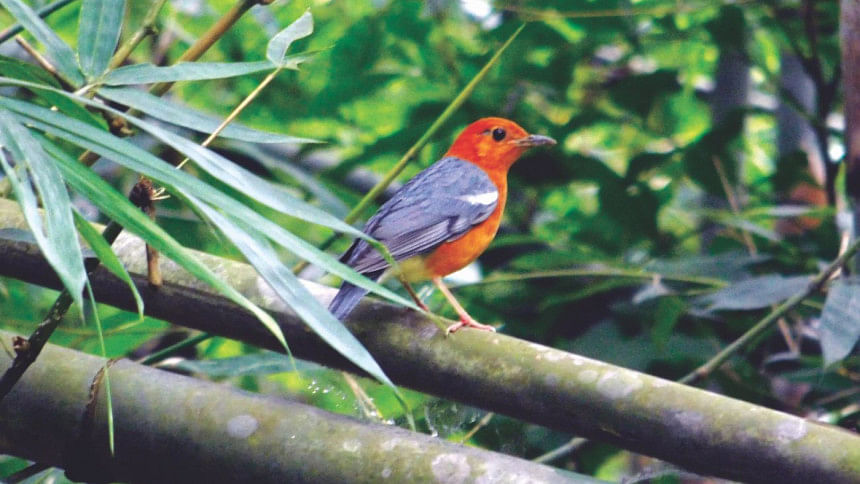Donning the shades of sunset

Owing its name to the beautiful shade of golden-orange splashed on their feathered bodies, the Orange-headed Thrush, scientifically known as Zoothera Citrina, are commonly known in the country as Komola Dama, Komolaphuli, Komola Doyel, or Komola Bou.
These little birds began spreading their population from northern India along the Himalayas to eastern Bangladesh, Sri Lanka, Java Island in Indonesia and northern Burma.
SM Iqbal, a local bird expert and associate professor of Zoology in Govt. MM Ali College in Tangail, said,
"These birds eat a wide range of insects and earthworms but are omnivorous. They choose their habitats in shady, damp areas like bamboo forests, and while they nest in the forest trees, they do not form flocks.
"This bird has 12 subspecies and, among them, the Komola Dama is a rare one because it is generally shy and can't be found in many places apart from a few specific locations. In Bangladesh, the majority of the Orange-headed Thrush's population is found in Bogura's Shajahanpur upazila because of the shady, wet bamboo forests where their food, such as earthworms, is found in abundance."
The expert further said that although this bird remains silent throughout winter, it sings loudly its sweet lilting melodious notes during the other seasons.
"Their mating period spans from April to June and to hatch their eggs, they build nests with dry leaves, mosses, and grasses atop a tree branches that are normally four to five metres high. The female birds lay three to four pink eggs, with blue and tea coloured marks, at a time, which usually hatch within 2 weeks. Orange-headed Thrush hatchlings take around 10 days after birth to learn to fly.
"Even though they don't form flocks, the Orange-headed Thrush hosts many other birds like cuckoos in their nests. However, the hosts' hatchlings often die due to this, as they cannot compete successfully with cuckoos for food," he added.
The global population of the Orange-headed Thrush is not believed to be under threat, and so the International Union for Conservation of Nature (IUCN) has listed the bird under the "Least Concern Species" category.
However, its numbers have begun declining in Java Island due to trapping for aviculture or capturing as caged-birds. In Bangladesh though, the bird has turned at least 15 bamboo forests in Bogura's Shahjahanpur upazila into their safe havens, Iqbal said.

 For all latest news, follow The Daily Star's Google News channel.
For all latest news, follow The Daily Star's Google News channel. 



Comments